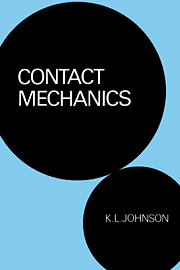Book contents
- Frontmatter
- Contents
- Preface
- 1 Motion and forces at a point of contact
- 2 Line loading of an elastic half-space
- 3 Point loading of an elastic half-space
- 4 Normal contact of elastic solids – Hertz theory
- 5 Non-Hertzian normal contact of elastic bodies
- 6 Normal contact of inelastic solids
- 7 Tangential loading and sliding contact
- 8 Rolling contact of elastic bodies
- 9 Rolling contact of inelastic bodies
- 10 Calendering and lubrication
- 11 Dynamic effects and impact
- 12 Thermoelastic contact
- 13 Rough surfaces
- Appendices
- References and author index
- Subject index
- Frontmatter
- Contents
- Preface
- 1 Motion and forces at a point of contact
- 2 Line loading of an elastic half-space
- 3 Point loading of an elastic half-space
- 4 Normal contact of elastic solids – Hertz theory
- 5 Non-Hertzian normal contact of elastic bodies
- 6 Normal contact of inelastic solids
- 7 Tangential loading and sliding contact
- 8 Rolling contact of elastic bodies
- 9 Rolling contact of inelastic bodies
- 10 Calendering and lubrication
- 11 Dynamic effects and impact
- 12 Thermoelastic contact
- 13 Rough surfaces
- Appendices
- References and author index
- Subject index
Summary
Real and apparent contact
It has been tacitly assumed so far in this book that the surfaces of contacting bodies are topographically smooth; that the actual surfaces follow precisely the gently curving nominal profiles discussed in Chapters 1 and 4. In consequence contact between them is continuous within the nominal contact area and absent outside it. In reality such circumstances are extremely rare. Mica can be cleaved along atomic planes to give an atomically smooth surface and two such surfaces have been used to obtain perfect contact under laboratory conditions. The asperities on the surface of very compliant solids such as soft rubber, if sufficiently small, may be squashed flat elastically by the contact pressure, so that perfect contact is obtained throughout the nominal contact area. In general, however, contact between solid surfaces is discontinuous and the real area of contact is a small fraction of the nominal contact area. Nor is it easy to flatten initially rough surfaces by plastic deformation of the asperities. For example the serrations produced by a lathe tool in the nominally flat ends of a ductile compression specimen will be crushed plastically by the hard flat platens of the testing machine. They will behave like plastic wedges (§6.2(c)) and deform plastically at a contact pressure ≈3Y where Y is the yield strength of the material. The specimen as a whole will yield in bulk at a nominal pressure of Y.
- Type
- Chapter
- Information
- Contact Mechanics , pp. 397 - 423Publisher: Cambridge University PressPrint publication year: 1985
- 4
- Cited by

